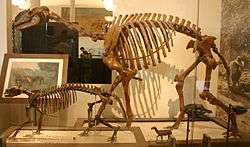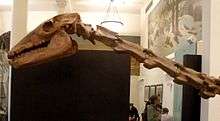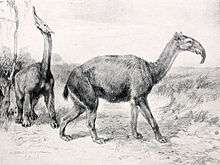Macrauchenia
| Macrauchenia | |
|---|---|
 | |
| M. patachonica (larger) and Phenacodus primaevus (smaller) | |
| Scientific classification | |
| Kingdom: | Animalia |
| Phylum: | Chordata |
| Class: | Mammalia |
| Order: | †Litopterna |
| Family: | †Macraucheniidae |
| Subfamily: | †Macraucheniinae |
| Genus: | †Macrauchenia |
| Type species | |
| Macrauchenia patachonica Owen, 1838 | |
| Species | |
|
†M. patachonica | |
Macrauchenia (name meaning "long llama", based on the now superseded Latin term for llamas, Auchenia, from Greek terms which literally means "big neck") was a long-necked and long-limbed, three-toed South American ungulate, typifying the order Litopterna.[1] The oldest fossils date to around seven million years ago, and M. patachonica disappears from the fossil record during the late Pleistocene, around 20,000-10,000 years ago. M. patachonica was the best known member of the family Macraucheniidae, and is known only from fossil finds in South America, primarily from the Luján Formation in Argentina. The type specimen was discovered by Charles Darwin during the voyage of the Beagle. In life, Macrauchenia resembled a humpless camel with a short trunk, though it is not closely related to either camels or proboscideans.[2]
Taxonomy
Macrauchenia was first discovered on 9 February 1834 at Port St Julian in Patagonia (Argentina) by Charles Darwin, when HMS Beagle was surveying the port during the voyage of the Beagle.[3] As a non-expert he tentatively identified the leg bones and fragments of spine he found as "some large animal, I fancy a Mastodon". In 1837, soon after the Beagle's return, the anatomist Richard Owen revealed that the bones including vertebrae from the back and neck were actually from a gigantic creature resembling a llama or camel, which Owen named Macrauchenia patachonica.[4] In naming it, Owen noted the original Greek terms Μακρος (large or long), and αυχην (neck) as used by Illiger as the basis of Auchenia as a generic name for the llama, Vicugna and so on.[5] The find was one of the discoveries leading to the inception of Darwin's theory. Since then, more Macrauchenia fossils have been found, mainly in Patagonia, but also in Bolivia, Chile and Venezuela.
The related genus Cramauchenia was named by Florentino Ameghino as a deliberate anagram of Macrauchenia.
Evolution

Macrauchenia appeared in the fossil record some seven million years ago in South America (in the Miocene epoch). It is likely that Macrauchenia arose from either Theosodon or Promacrauchenia. Notoungulata and Litopterna were two ancient orders of ungulates which occurred only in South America. Most of these species became extinct through competition with invading North American ungulates during the Great American Interchange, after the establishment of the Central American land bridge. The litopterns Macrauchenia and the horse-like Neocaliphrium and the large notungulates Toxodon and Mixotoxodon were among the only South American ungulate genera to survive the Interchange (Mixotoxodon also turned the tables and invaded Mesoamerica). These last endemic South American hoofed animals died out at the end of the Lujanian (10,000-20,000 years ago)[6] at roughly the time of arrival of humans at the end of the Pleistocene, along with numerous other large animals on the American continent (such as ground sloths, glyptodonts, American proboscideans, horses, camelids, short-faced bears and sabre-toothed cats).
Sequencing of mitochondrial DNA extracted from an M. patachonica fossil from a cave in southern Chile indicates that Macrauchenia (and by inference, Litopterna) is the sister group to Perissodactyla, with an estimated divergence date of sixty-six million years ago.[7][8] Analysis of collagen sequences obtained from Macrauchenia and Toxodon reached a similar conclusion and extended membership in the sister group clade to notoungulates.[9][10]
Description

Macrauchenia had a somewhat camel-like body, with sturdy legs, a long neck and a relatively small head. Its feet, however, more closely resembled those of a modern rhinoceros, and had toes hooves each. It was a relatively large animal, with a body length of around 3 metres (9.8 ft) and a weight up to 1042.8 kg.[11][12]
One striking characteristic of Macrauchenia is that, unlike most other mammals, the openings for nostrils on its skull were atop the head, leading some early scientists to believe that, much like a whale, it used these nostrils as a form of snorkel. Soon after some more recent findings, this theory was rejected. An alternative theory is that the ungulate possessed a trunk, perhaps to keep dust out of the nostrils.[11] Macrauchenia's trunk may be comparable to that of the modern Saiga antelope.
One insight into Macrauchenia's habits is that its ankle joints and shin bones may indicate that it was adapted to have unusually good mobility, being able to rapidly change direction when it ran at high speed.[2]
Macrauchenia is known, like its relative Theosodon, to have had a full set of 44 teeth.
Paleobiology
.jpg)
Macrauchenia was a herbivore, likely living on leaves from trees or grasses. Carbon isotope analysis of M. patachonica's tooth enamel, as well as analysis of its hypsodonty index (low in this case; i.e., it was brachydont), body size and relative muzzle width suggests that it was a mixed feeder, combining browsing on C3 foliage with grazing on C4 grasses.[13] Scientists believe that, because of the forms of its teeth, Macrauchenia ate using its trunk to grasp leaves and other food. It is also believed that it lived in herds like modern-day wildebeest or antelope, the better to escape predators.
When Macrauchenia first arose, it would have been preyed upon by the largest of native South American predators, terror birds such as Andalgalornis, and carnivorous sparassodontids such as Thylacosmilus. During the late Pliocene/Early Pleistocene, the Panama Isthmus formed, allowing predators of North American origin, such as the cougar, the jaguar, the South American giant short-faced bear, the dire wolf and the saber-toothed cat, Smilodon, to emigrate into South America and replace the native forms.
It is presumed that Macrauchenia dealt with its predators primarily by outrunning them, or, failing that, kicking them with its long, powerful legs, much like modern-day vicuña or camels. Its potential ability to twist and turn at high speed could have enabled it to evade pursuers.[2]
Distribution
Fossils of Macrauchenia have been found in:[14]
- Miocene
- Epecuén Formation, Argentina
- Pliocene
- Pleistocene
- Arroyo Seco and Luján Formations, Argentina
- Ulloma, Charana, Umala, Tarija and Ñuapua Formations, Bolivia
- Touro Passo Formation, Brazil
- Cueva del Milodón, Chile
- Paraguay
- San Sebastián Formation, Peru
- Sopas and Dolores Formations, Uruguay
- Taima-Taima, Venezuela
References
- ↑

- 1 2 3 "BBC - Science & Nature - Wildfacts - Macrauchenia". Retrieved 2009-06-15.
- ↑ ed. Keynes, R. D. (2001). "Charles Darwin's Beagle Diary". Cambridge University Press. p. 214. Retrieved 2008-12-19.
- ↑ "Darwin Correspondence Project - Letter 238 — Darwin, C. R. to Henslow, J. S., Mar 1834". Retrieved 2008-12-19.
- ↑ Owen 1838, p. 35
- ↑ Alberto L. Cione, Eduardo P. Tonni, Leopoldo Soibelzon: The Broken Zig-Zag: Late Cenozoic large mammal and tortoise extinction in South America. In: Revista del Museo Argentino de Ciencias Naturales. 5, 1, 2003, ISSN 1514-5158, S. 1–19, online Archived 2011-07-06 at the Wayback Machine.
- ↑ Westbury, M.; Baleka, S.; Barlow, A.; Hartmann, S.; Paijmans, J. L. A.; Kramarz, A.; Forasiepi, A. M.; Bond, M.; Gelfo, J. N.; Reguero, M. A.; López-Mendoza, P.; Taglioretti, M.; Scaglia, F.; Rinderknecht, A.; Jones, W.; Mena, F.; Billet, G.; de Muizon, C.; Aguilar, J. L.; MacPhee, R. D. E.; Hofreiter, M. (2017-06-27). "A mitogenomic timetree for Darwin's enigmatic South American mammal Macrauchenia patachonica". Nature Communications. 8: 15951. doi:10.1038/ncomms15951.
- ↑ Strickland, A. (June 27, 2017). "DNA solves ancient animal riddle that Darwin couldn't". CNN. Retrieved June 27, 2017.
- ↑ Welker, F.; Collins, M. J.; Thomas, J. A.; Wadsley, M.; Brace, S.; Cappellini, E.; Turvey, S. T.; Reguero, M.; Gelfo, J. N.; Kramarz, A.; Burger, J.; Thomas-Oates, J.; Ashford, D. A.; Ashton, P. D.; Rowsell, K.; Porter, D. M.; Kessler, B.; Fischer, R.; Baessmann, C.; Kaspar, S.; Olsen, J. V.; Kiley, P.; Elliott, J. A.; Kelstrup, C. D.; Mullin, V.; Hofreiter, M.; Willerslev, E.; Hublin, J.-J.; Orlando, L.; Barnes, I.; MacPhee, R. D. E. (2015-03-18). "Ancient proteins resolve the evolutionary history of Darwin's South American ungulates". Nature. 522: 81–84. doi:10.1038/nature14249. ISSN 0028-0836. PMID 25799987.
- ↑ Buckley, M. (2015-04-01). "Ancient collagen reveals evolutionary history of the endemic South American 'ungulates'". Proceedings of the Royal Society B: Biological Sciences. 282 (1806): 20142671–20142671. doi:10.1098/rspb.2014.2671. PMC 4426609.
- 1 2 Palmer, D., ed. (1999). The Marshall Illustrated Encyclopedia of Dinosaurs and Prehistoric Animals. London: Marshall Editions. p. 248. ISBN 1-84028-152-9.
- ↑ http://sedici.unlp.edu.ar/handle/10915/16838?show=full (in spanish)
- ↑ MacFadden, B. J.; Shockey, B. J. (Winter 1997). "Ancient feeding ecology and niche differentiation of Pleistocene mammalian herbivores from Tarija, Bolivia: morphological and isotopic evidence". Paleobiology. Paleontological Society. 23 (1): 77–100. JSTOR 2401158.
- ↑ Macrauchenia at Fossilworks.org
Further reading
- Barry Cox, Colin Harrison, R.J.G. Savage, and Brian Gardiner. (1999): The Simon & Schuster Encyclopedia of Dinosaurs and Prehistoric Creatures: A Visual Who's Who of Prehistoric Life. Simon & Schuster.
- Jayne Parsons. (2001): Dinosaur Encyclopedia. DK.
- Owen, Richard (1838). "Description of Parts of the Skeleton of Macrauchenia patachonica". In Darwin, C. R. Fossil Mammalia Part 1 No. 1. The zoology of the voyage of H.M.S. Beagle. London: Smith Elder and Co.
External links
| Wikisource has the text of the 1911 Encyclopædia Britannica article macrauchenia. |
| Wikimedia Commons has media related to Macrauchenia. |